4.2: Separation and confirmation of individual ions in group II precipitates
- Page ID
- 369534
\( \newcommand{\vecs}[1]{\overset { \scriptstyle \rightharpoonup} {\mathbf{#1}} } \)
\( \newcommand{\vecd}[1]{\overset{-\!-\!\rightharpoonup}{\vphantom{a}\smash {#1}}} \)
\( \newcommand{\id}{\mathrm{id}}\) \( \newcommand{\Span}{\mathrm{span}}\)
( \newcommand{\kernel}{\mathrm{null}\,}\) \( \newcommand{\range}{\mathrm{range}\,}\)
\( \newcommand{\RealPart}{\mathrm{Re}}\) \( \newcommand{\ImaginaryPart}{\mathrm{Im}}\)
\( \newcommand{\Argument}{\mathrm{Arg}}\) \( \newcommand{\norm}[1]{\| #1 \|}\)
\( \newcommand{\inner}[2]{\langle #1, #2 \rangle}\)
\( \newcommand{\Span}{\mathrm{span}}\)
\( \newcommand{\id}{\mathrm{id}}\)
\( \newcommand{\Span}{\mathrm{span}}\)
\( \newcommand{\kernel}{\mathrm{null}\,}\)
\( \newcommand{\range}{\mathrm{range}\,}\)
\( \newcommand{\RealPart}{\mathrm{Re}}\)
\( \newcommand{\ImaginaryPart}{\mathrm{Im}}\)
\( \newcommand{\Argument}{\mathrm{Arg}}\)
\( \newcommand{\norm}[1]{\| #1 \|}\)
\( \newcommand{\inner}[2]{\langle #1, #2 \rangle}\)
\( \newcommand{\Span}{\mathrm{span}}\) \( \newcommand{\AA}{\unicode[.8,0]{x212B}}\)
\( \newcommand{\vectorA}[1]{\vec{#1}} % arrow\)
\( \newcommand{\vectorAt}[1]{\vec{\text{#1}}} % arrow\)
\( \newcommand{\vectorB}[1]{\overset { \scriptstyle \rightharpoonup} {\mathbf{#1}} } \)
\( \newcommand{\vectorC}[1]{\textbf{#1}} \)
\( \newcommand{\vectorD}[1]{\overrightarrow{#1}} \)
\( \newcommand{\vectorDt}[1]{\overrightarrow{\text{#1}}} \)
\( \newcommand{\vectE}[1]{\overset{-\!-\!\rightharpoonup}{\vphantom{a}\smash{\mathbf {#1}}}} \)
\( \newcommand{\vecs}[1]{\overset { \scriptstyle \rightharpoonup} {\mathbf{#1}} } \)
\( \newcommand{\vecd}[1]{\overset{-\!-\!\rightharpoonup}{\vphantom{a}\smash {#1}}} \)
\(\newcommand{\avec}{\mathbf a}\) \(\newcommand{\bvec}{\mathbf b}\) \(\newcommand{\cvec}{\mathbf c}\) \(\newcommand{\dvec}{\mathbf d}\) \(\newcommand{\dtil}{\widetilde{\mathbf d}}\) \(\newcommand{\evec}{\mathbf e}\) \(\newcommand{\fvec}{\mathbf f}\) \(\newcommand{\nvec}{\mathbf n}\) \(\newcommand{\pvec}{\mathbf p}\) \(\newcommand{\qvec}{\mathbf q}\) \(\newcommand{\svec}{\mathbf s}\) \(\newcommand{\tvec}{\mathbf t}\) \(\newcommand{\uvec}{\mathbf u}\) \(\newcommand{\vvec}{\mathbf v}\) \(\newcommand{\wvec}{\mathbf w}\) \(\newcommand{\xvec}{\mathbf x}\) \(\newcommand{\yvec}{\mathbf y}\) \(\newcommand{\zvec}{\mathbf z}\) \(\newcommand{\rvec}{\mathbf r}\) \(\newcommand{\mvec}{\mathbf m}\) \(\newcommand{\zerovec}{\mathbf 0}\) \(\newcommand{\onevec}{\mathbf 1}\) \(\newcommand{\real}{\mathbb R}\) \(\newcommand{\twovec}[2]{\left[\begin{array}{r}#1 \\ #2 \end{array}\right]}\) \(\newcommand{\ctwovec}[2]{\left[\begin{array}{c}#1 \\ #2 \end{array}\right]}\) \(\newcommand{\threevec}[3]{\left[\begin{array}{r}#1 \\ #2 \\ #3 \end{array}\right]}\) \(\newcommand{\cthreevec}[3]{\left[\begin{array}{c}#1 \\ #2 \\ #3 \end{array}\right]}\) \(\newcommand{\fourvec}[4]{\left[\begin{array}{r}#1 \\ #2 \\ #3 \\ #4 \end{array}\right]}\) \(\newcommand{\cfourvec}[4]{\left[\begin{array}{c}#1 \\ #2 \\ #3 \\ #4 \end{array}\right]}\) \(\newcommand{\fivevec}[5]{\left[\begin{array}{r}#1 \\ #2 \\ #3 \\ #4 \\ #5 \\ \end{array}\right]}\) \(\newcommand{\cfivevec}[5]{\left[\begin{array}{c}#1 \\ #2 \\ #3 \\ #4 \\ #5 \\ \end{array}\right]}\) \(\newcommand{\mattwo}[4]{\left[\begin{array}{rr}#1 \amp #2 \\ #3 \amp #4 \\ \end{array}\right]}\) \(\newcommand{\laspan}[1]{\text{Span}\{#1\}}\) \(\newcommand{\bcal}{\cal B}\) \(\newcommand{\ccal}{\cal C}\) \(\newcommand{\scal}{\cal S}\) \(\newcommand{\wcal}{\cal W}\) \(\newcommand{\ecal}{\cal E}\) \(\newcommand{\coords}[2]{\left\{#1\right\}_{#2}}\) \(\newcommand{\gray}[1]{\color{gray}{#1}}\) \(\newcommand{\lgray}[1]{\color{lightgray}{#1}}\) \(\newcommand{\rank}{\operatorname{rank}}\) \(\newcommand{\row}{\text{Row}}\) \(\newcommand{\col}{\text{Col}}\) \(\renewcommand{\row}{\text{Row}}\) \(\newcommand{\nul}{\text{Nul}}\) \(\newcommand{\var}{\text{Var}}\) \(\newcommand{\corr}{\text{corr}}\) \(\newcommand{\len}[1]{\left|#1\right|}\) \(\newcommand{\bbar}{\overline{\bvec}}\) \(\newcommand{\bhat}{\widehat{\bvec}}\) \(\newcommand{\bperp}{\bvec^\perp}\) \(\newcommand{\xhat}{\widehat{\xvec}}\) \(\newcommand{\vhat}{\widehat{\vvec}}\) \(\newcommand{\uhat}{\widehat{\uvec}}\) \(\newcommand{\what}{\widehat{\wvec}}\) \(\newcommand{\Sighat}{\widehat{\Sigma}}\) \(\newcommand{\lt}{<}\) \(\newcommand{\gt}{>}\) \(\newcommand{\amp}{&}\) \(\definecolor{fillinmathshade}{gray}{0.9}\)Separation and confirmation of tin(IV) ion
Among the sulfides of group II, only \(\ce{SnS2}\) is amphoteric and reacts with \(\ce{OH^{-}}\) ions in an alkaline medium to produce \(\ce{[Sn(OH)6]^{2-}}\) -a coordination complex anion, and stannate ion \(\ce{[SnS3]^{2-}}\), both are water-soluble. 3M \(\ce{KOH}\) is mixed with the precipitates of group II ions and the mixture is heated to dissolve the \(\ce{SnS2}\) through the following equilibrium reaction:
\[\ce{3SnS2(s, yellow) + 6OH^{-}(aq) <=> [Sn(OH)6]^{2-}(aq) + 2[SnS3]^{2-}(aq)}\nonumber\]
The hot solution is centrifuged and decanted to separate the supernatant that contains \(\ce{[Sn(OH)6]^{2-}}\) and \(\ce{[SnS3]^{2-}}\) dissolved in it and the precipitate that contains the sulfides of the rest of the group II cations, as shown in Figure \(\PageIndex{1}\). A better approach is to separate the supernatant by aspiration using the cotton-plug technique to avoid contamination of precipitates in the supernatant.
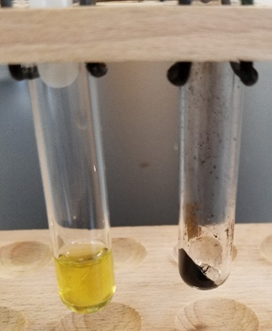
The above reaction is reversible, which means removing \(\ce{OH^{-}}\) from the supernatant by acid-base neutralization reaction moves the equilibrium in the reverse direction re-producing yellow \(\ce{SnS2}\) precipitate as shown in Figure \(\PageIndex{2}\).
\[\ce{[Sn(OH)6]^{2-}(aq) + 2[SnS3]^{2-}(aq) <=> 3SnS2(s, yellow) + 6OH^{-}(aq)}\nonumber\]
\[\ce{6HCl(aq) + 6OH^{-}(aq) <=> 6H2O(l) + 6Cl^{-}(aq)}\nonumber\]
\[\text{Overall reaction: }\ce{~6HCl(aq) + [Sn(OH)6]^{2-}(aq) + 2[SnS3]^{2-}(aq) <=> 3SnS2(s, yellow) + 6H2O(l)}\nonumber\]
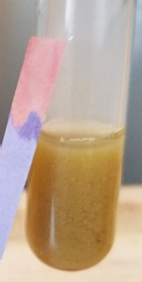
Some of the sulfides may be lost due to air oxidation of \(\ce{H2S}\) by the following reaction:
\[\ce{2H2S(aq) + O2(g) <=> 2S(s, whitish-yellow) + 2H2O(l)}\nonumber\]
To compensate for the loss of sulfide, 1M thioacetamide solution is also added along with 6M \(\ce{HCl}\) to the supernatant and the mixture is heated to reform the yellow \(\ce{SnS2}\) precipitate that confirms the presence of \(\ce{Sn^{4+}}\) in the test solution. Note that both S and \(\ce{SnS2}\) are yellow solids. Add 3M \(\ce{KOH}\) solution to the mixture to turn it alkaline again the \(\ce{SnS2}\) precipitate will re-dissolve confirming \(\ce{Sn^{4+}}\) is present in the test solution. The \(\ce{S}\) particles will not re-dissolve.
Separation and confirmation of cadmium(II) ion
\(\ce{CdS}\) is the most soluble sulfide among group II sulfide precipitates. According to Le Chatelier's principle, the removal of products, i.e., \(\ce{Cd^{2+}}\) and \(\ce{S^{2-}}\) of the dissolution reaction in this case, drives the reaction forward. \(\ce{CdS}\) can be redissolved by adding 1M \(\ce{HCl}\) to the precipitates after the removal of \(\ce{Sn^{4+}}\). Dissociation of \(\ce{HCl}\) produces \(\ce{H3O^{+}}\) in water that removes S2- by forming \(\ce{H2S}\) which is a weak acid. At the same time, Cl- removes \(\ce{Cd^{2+}}\) b y forming soluble coordination complex anion \(\ce{[CdCl4]^{2-}}\) which is quite stable with \(K_f\) = 6.3×102:
\[\ce{CdS(s, yellow-orange) <=> Cd^{2+}(aq) + S^{2-}(aq)}\nonumber\]
\[\ce{4HCl(aq) + 4H2O(l) <=> 4H3O^{+}(aq) + 4Cl^{-}(aq)}\nonumber\]
\[\ce{S^{2-}(aq) + 2H3O^{+}(aq) <=> H2S(aq) + 2H2O(l)}\nonumber\]
\[\ce{Cd^{2+}(aq) + 4Cl^{-}(aq) <=> [CdCl4]^{2-}(aq)}\nonumber\]
\[\text{Overall reaction:} \ce{~CdS(s, yellow-orange) + 4HCl(aq) + 2H2O(l) <=> [CdCl4]^{2-}(aq) + 2H3O^{+}(aq) +H2S(aq)}\nonumber\]
The dissolution of \(\ce{CdS}\)is facilitated by heating the reaction mixture. The rest of the group II cations, i.e., \(\ce{CuS}\) and \(\ce{Bi2S3}\) are very insoluble and do not dissolve under these conditions. The solution is centrifuged and decanted or aspirated to separate the supernatant that contains \(\ce{[CdCl4]^{2-}}\) and the precipitate that contains \(\ce{CuS}\) and/or \(\ce{Bi2S3}\) if \(\ce{Cu^{2+}}\) and/or \(\ce{Bi^{3+}}\) are present. The precipitate tends to go into the supernatant, so, the cotton plug technique is needed to prevent precipitates from going into the supernatant during the separation as shown in Figure \(\PageIndex{3}\).
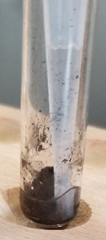
All the reactions responsible for the dissolution of \(\ce{CdS}\) are reversible. The addition of \(\ce{HCl}\) dissolves \(\ce{CdS}\) by moving the equilibrium forward and the removal of \(\ce{HCl}\) moves the equilibrium in the reverse direction to reform yellow \(\ce{CdS}\) precipitate. Ammonia \(\ce{NH3}\) is such a base that removes \(\ce{HCl}\)l:
\[\ce{HCl(aq) + NH3(aq) <=> NH4Cl(aq)}\nonumber\]
6M \(\ce{NH3}\) solution is added drop by drop under stirring and tested with red-litmus paper till the solution turns alkaline. If yellow precipitate forms, it is \(\ce{CdS}\) confirming \(\ce{Cd^{2+}}\) was present in the test solution:
\[\ce{[CdCl4]^{2-} +2H3O^{+} + H2S(aq) + 4NH3(aq)<=> CdS(s, yellow-orange)(v) +4NH4^{+}(aq) + Cl^{-} + 2H2O(l)}\nonumber\]
If no precipitate forms, add 1M thioacetamide and heat to make up for any loss of \(\ce{S^{2-}}\) in the solution. If yellow precipitate forms, it is \(\ce{CdS}\) confirming \(\ce{Cd^{2+}}\) is present in the test solution as shown in Figure \(\PageIndex{4}\).
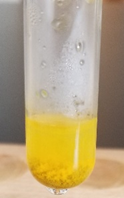
Separation and confirmation of copper(II) ion and bismuth(III) ion
After removal of \(\ce{Sn^{4+}}\) and \(\ce{Cd^{2+}}\), if there is a precipitate left it could be \(\ce{CuS}\) and/or \(\ce{Bi2S3}\), which are the least soluble sulfides in group II. To dissolve \(\ce{CuS}\) and \(\ce{Bi2S3}\), the \(\ce{S^{2-}}\) in the products need to be removed to a higher extent than in the case of \(\ce{CdS}\) re-dissolution.
Nitric acid provides \(\ce{NO3^{2-}}\) which is a strong oxidizing agent that can remove \(\ce{S^{2-}}\) sufficient to drive the equilibrium forward to dissolve \(\ce{CuS}\) and \(\ce{Bi2S3}\).
\[\ce{Bi2S3(s, black) <=> 2Bi^{3+}(aq) + 3S^{2-}(aq)}\nonumber\]
\[\ce{3S^{2-}(aq) + 2NO3^{-}(aq) + 8H3O^{+}(aq) <=> 3S(s, yellow)(v) + 2NO(g)(^) + 12H2O(l)}\nonumber\]
\[\text{Overall reaction:}\ce{~Bi2S3(s, black) + 2NO3^{-}(aq) + 8H3O^{+}(aq) <=> 3S(s, yellow)(v) + 2Bi^{3+}(aq) + 2NO(g)(^) + 12H2O(l)}\nonumber\]
\[\ce{3CuS(s, black-brown) <=> 3Cu^{2+}(aq) + 3S^{2-}(aq)}\nonumber\]
\[\ce{3S^{2-}(aq) + 2NO3^{-}(aq) + 8H3O^{+}(aq) <=> 3S(s, yellow)(v) + 2NO(g)(^) + 12H2O(l)}\nonumber\]
\[\text{Overall reaction:}\ce{~3CuS(s, black-brown) + 2NO3^{-}(aq) + 8H3O^{+}(aq) <=> 3S(s, yellow)(v) + 2Cu^{2+}(aq) + 2NO(g)(^) + 12H2O(l)}\nonumber\]
The mixture is heated to enhance the above reactions. The \(\ce{S^{2-}}\) is oxidized to solid light-yellow colored sulfur particles. Brown colored fumes are observed over the solution as a result of air oxidation of nitric oxide (\(\ce{NO}\)) that evaporates out of the solution as shown in Figure \(\PageIndex{5}\):
\[\ce{2NO(g) + O2(g) <=> 2NO2(g, red-brown)}\nonumber\]
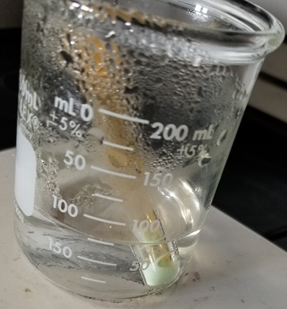
Removal of \(\ce{NO}\) and \(\ce{S^{2-}}\) from the products drives the reaction in the forward direction based on Le Chatelier's principle.
The solid sulfur precipitate is removed by centrifugation followed by decantation.
The supernatant is acidic and appears light blue if copper ions are present, as shown in Figure \(\PageIndex{6}\).
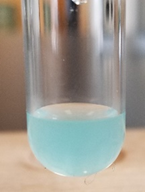
If the solution is made alkaline, \(\ce{Cu^{2+}}\), and \(\ce{Bi^{3+}}\) form solid hydroxides. However, aqueous ammonia (\(\ce{NH3}\)) selectively precipitate out\(\ce{Bi(OH)3}\), while keeping copper dissolved as coordination complex ions, \(\ce{[Cu(NH3)4]^{2+}}\):
\[\ce{Bi^{3+}(aq) + 3NH3(aq) + 3H2O(l) <=> Bi(OH)3(s, white)(v) + 3NH4^{+}(aq)}\quad K = 3.3\times10^{39}\nonumber\]
\[\ce{Cu^{2+}(aq) + 4NH3(aq) <=> [Cu(NH3)4]^{2+}(aq, blue)}\quad K = 3.8\times10^{12}\nonumber\]
The solution is made alkaline by adding 6M \(\ce{NH3}\) drop by drop and tested using red-litmus paper. Excess \(\ce{NH3}\) solution is added to make sure that any residual \(\ce{Cd^{2+}}\) is also removed as \(\ce{[Cu(NH3)4]^{2+}}\). If the supernatant turns blue by making it alkaline with ammonia, it confirms \(\ce{Cu^{2+}}\) is present in the test sample, as shown in Figure \(\PageIndex{7}\). The presence of residual \(\ce{Cd^{2+}}\) does not interfere because it forms a colorless \(\ce{[Cu(NH3)4]^{2+}}\) ion.
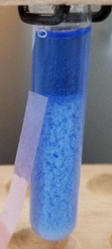
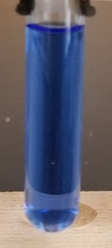
The mixture is centrifuged and decanted to separate the white precipitate of \(\ce{Bi(OH)3}\), but, if ammonia addition was not sufficient, white \(\ce{Cd(OH)2}\) may also form from any residual \(\ce{Cd^{2+}}\) ions:
\[\ce{Cd^{2+}(aq) + 2NH3(aq) + 2H2O(l)<=> Cd(OH)2(s, white)(v) + 2NH4^{+}}\nonumber\]
The precipitate is resuspended in 6M \(\ce{NH3}\) to redissolve \(\ce{Cd(OH)2}\), if there is any present. \(\ce{Bi(OH)3}\) precipitate does not dissolve in 6M \(\ce{NH3}\). If the white precipitate persists after washing with 6M \(\ce{NH3}\) it confirms \(\ce{Bi^{3+}}\) is present in the test solution, as shown in Figure \(\PageIndex{8}\).



